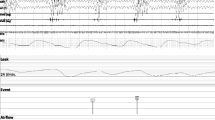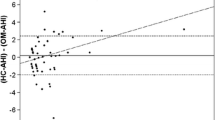Abstract
Purpose
To compare the apnea–hypopnea indices (AHIs) derived using three hypopnea definitions published by the American Academy of Sleep Medicine (AASM) and to determine the impact of the new modifications of the definition on AHIs and the diagnosis of obstructive sleep apnea (OSA).
Methods
The study comprised 100 consecutive patients who were investigated for OSA using overnight diagnostic polysomnography (PSG). The hypopneas were scored in three passes by two certified sleep technologists; in the first pass, the hypopneas were scored using the 2007 AASM “Alternative” (H Alt) criteria. In the second pass, the hypopneas were scored using the 2007 AASM “Recommended” (H Rec) criteria. In the third pass, the hypopneas were scored according to the new AASM “2012” (H 2012) criteria. Agreement analysis of the results obtained using the three scoring criteria was performed using the Bland–Altman plot methodology.
Results
The studied group had a mean age of 45.5 ± 12.6 years and a body mass index of 30.2 ± 5.8 kg/m2. Using the H 2012, H Rec and H Alt criteria, the AHIs were 37.9 ± 27.6, 14.8 ± 22.4 and 29.6 ± 27.0/h, respectively (p < 0.05). The Bland–Altman analysis of the AHI demonstrated that more events were nearly always detected using the H 2012 definition.
Conclusion
A significant difference in detecting hypopnea events exists among the H 2012, H Rec and H Alt definitions. The 2007 AASM “Recommended” definition tended to result in lower AHI than the other two definitions.



Similar content being viewed by others
References
Jung R, Kuhlo W (1965) Neurophysiological studies of abnormal night sleep and the Pickwickian syndrome. Prog Brain Res 18:140–159
Gould GA, Whyte KF, Rhind GB, Airlie MA, Catterall JR, Shapiro CM, Douglas NJ (1988) The sleep hypopnea syndrome. Am Rev Respir Dis 137(4):895–898
Manser RL, Rochford P, Pierce RJ, Byrnes GB, Campbell DA (2001) Impact of different criteria for defining hypopneas in the apnea–hypopnea index. Chest 120(3):909–914
Tsai WH, Flemons WW, Whitelaw WA, Remmers JE (1999) A comparison of apnea–hypopnea indices derived from different definitions of hypopnea. Am J Respir Crit Care Med 159(1):43–48
Redline S, Kapur VK, Sanders MH, Quan SF, Gottlieb DJ, Rapoport DM, Bonekat WH, Smith PL, Kiley JP, Iber C (2000) Effects of varying approaches for identifying respiratory disturbances on sleep apnea assessment. Am J Respir Crit Care Med 161(2 Pt 1):369–374
Sleep-related breathing disorders in adults: recommendations for syndrome definition and measurement techniques in clinical research. The Report of an American Academy of Sleep Medicine Task Force (1999). Sleep 22 (5):667–689.
Iber C, Ancoli-Israel S, Chesson AL Jr, Quan SF (2007) The AASM manual for the scoring of sleep and associated events: rules, terminology and technical specifications, 1st edn. American Academy of Sleep Medicine, Westchester, IL
Berry RB, Budhiraja R, Gottlieb DJ, Gozal D, Iber C, Kapur VK, Marcus CL, Mehra R, Parthasarathy S, Quan SF, Redline S, Strohl KP, Davidson Ward SL, Tangredi MM (2012) Rules for scoring respiratory events in sleep: update of the 2007 AASM Manual for the Scoring of Sleep and Associated Events. Deliberations of the Sleep Apnea Definitions Task Force of the American Academy of Sleep Medicine. J Clin Sleep Med 8(5):597–619
Guilleminault C, Hagen CC, Huynh NT (2009) Comparison of hypopnea definitions in lean patients with known obstructive sleep apnea hypopnea syndrome (OSAHS). Sleep Breath 13(4):341–347
Ruehland WR, Rochford PD, O'Donoghue FJ, Pierce RJ, Singh P, Thornton AT (2009) The new AASM criteria for scoring hypopneas: impact on the apnea hypopnea index. Sleep 32(2):150–157
Accardo JA, Shults J, Leonard MB, Traylor J, Marcus CL (2010) Differences in overnight polysomnography scores using the adult and pediatric criteria for respiratory events in adolescents. Sleep 33(10):1333–1339
Johns MW (1992) Reliability and factor analysis of the Epworth Sleepiness Scale. Sleep 15(4):376–381
AASM (1999) Sleep-related breathing disorders in adults: recommendations for syndrome definition and measurement techniques in clinical research. The Report of an American Academy of Sleep Medicine Task Force. Sleep 22(5):667–689
Bland JM, Altman DG (1986) Statistical methods for assessing agreement between two methods of clinical measurement. Lancet 1(8476):307–310
Whitney CW, Gottlieb DJ, Redline S, Norman RG, Dodge RR, Shahar E, Surovec S, Nieto FJ (1998) Reliability of scoring respiratory disturbance indices and sleep staging. Sleep 21(7):749–757
AASM suspends required use of 3 percent hypopnea desaturation scoring criterion. (2013) American Academy of Sleep Medicine. http://www.aasmnet.org/articles.aspx?id = 4132. Accessed November 23, 2013
Guilleminault C, Stoohs R, Clerk A, Cetel M, Maistros P (1993) A cause of excessive daytime sleepiness. The upper airway resistance syndrome. Chest 104(3):781–787
Bonnet MH, Doghramji K, Roehrs T, Stepanski EJ, Sheldon SH, Walters AS, Wise M, Chesson AL Jr (2007) The scoring of arousal in sleep: reliability, validity, and alternatives. J Clin Sleep Med 3(2):133–145
Peppard PE, Ward NR, Morrell MJ (2009) The impact of obesity on oxygen desaturation during sleep-disordered breathing. Am J Respir Crit Care Med 180(8):788–793
Bradley TD, Martinez D, Rutherford R, Lue F, Grossman RF, Moldofsky H, Zamel N, Phillipson EA (1985) Physiological determinants of nocturnal arterial oxygenation in patients with obstructive sleep apnea. J Appl Physiol 59(5):1364–1368
Parrino L, Ferri R, Zucconi M, Fanfulla F (2009) Commentary from the Italian Association of Sleep Medicine on the AASM manual for the scoring of sleep and associated events: for debate and discussion. Sleep Med 10(7):799–808
Collop NA, Anderson WM, Boehlecke B, Claman D, Goldberg R, Gottlieb DJ, Hudgel D, Sateia M, Schwab R (2007) Clinical guidelines for the use of unattended portable monitors in the diagnosis of obstructive sleep apnea in adult patients. Portable Monitoring Task Force of the American Academy of Sleep Medicine. J Clin Sleep Med 3(7):737–747
Acknowledgments
This project was funded by The National Plan for Sciences and Technology (King Saud University and King Abdulaziz City for Science and Technology).
Author information
Authors and Affiliations
Corresponding author
Rights and permissions
About this article
Cite this article
BaHammam, A.S., Obeidat, A., Barataman, K. et al. A comparison between the AASM 2012 and 2007 definitions for detecting hypopnea. Sleep Breath 18, 767–773 (2014). https://doi.org/10.1007/s11325-014-0939-3
Received:
Revised:
Accepted:
Published:
Issue Date:
DOI: https://doi.org/10.1007/s11325-014-0939-3




